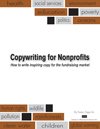Once again I find myself in partial disagreement with the good folks at “Nonprofit 2.0.” On Monday they published a post titled, 11 Nonprofit Websites Designed for the Social Web.
I’m not in complete agreement that the 11 examples they cited are great examples to emulate.
My primary concern is that these websites have too much for the eye to focus on – there’s too much competing – screaming – for our attention. And that lowers conversions. In other words, FEWER visitors TAKE ACTION (respond to your call-to-action).
Fewer conversions is the risk you take
with a website dominated by images
Here’s what I mean . . .
Yes we are more visual and this includes watching videos (although the stats for what is watched start-to-finish are extremely low; few people watch beyond 10 seconds). And we don’t want a mass of text. That’s never been the right approach for the web.
Plus it’s always been smart to have obvious placement of “Donate Now” buttons, and e-newsletter “Subscribe” sign-ups. However, on the home page I believe these should dominate and the social networking icons should NOT be located nearby.
And yes, we like images (e.g., photos). But although we may be more visual, repeated testing of what donors and supporters do proves that they still want to get basic questions answered. And for a website they want these answers within 5 seconds of landing on your site.
So if you don’t have enough copy to answer those questions; and if they have so many images, buttons, and bright colors to look at that their eye doesn’t know WHAT to focus one … then you’ve missed the boat.
Remember: A home page is also a landing page. And you need to have your primary CTA above the fold.
Of the eleven websites touted as “excellent examples” I’d love to see data on these websites. What about A/B split tests of people landing on the new design versus a varied design? Then compare conversion statistics for the two designs.
Base web design on testing
Designs ought to be based on tangible testing and not a clutter of cool pictures and videos that the staff is in love with.
Clarity trumps “oh this is such a pretty picture” every time. Clarity trumps “clever” every time. Stated another way:
o Is it obvious to VISITORS what you want them to do on this page? What is the primary action you want them to take? If they did nothing else they would _____ (fill in the blank).
If it’s to look at a photo, then fill up the entire screen above the fold with the photo. Personally I don’t see how looking at a photo alone can acquire more donors or members; get more people to donate; get more people to be email subscribers; etc.
o Don’t have so many buttons and calls-to-action that you get fewer conversions because people can’t decide. And by fewer conversions I’m referring to fewer donations, fewer sign-ups, fewer everything except oohs and ahs over the pretty graphics.
o I say again: Think twice, three times and more before you fill up the entire screen “above the fold” with a single photo or video. But if someone on your staff insists, then at least do an A/B split test for 3-6 months (tweaking along the way) and collect conversion data. Which design did the best job of meeting your business goals?
By the way; I love photos. Photography is a hobby I’ve enjoyed since I was 9 or 10 years old.
Photos don’t answer critical donor questions
Looking at a terrific photo of the beach doesn’t tell me exactly what your nonprofit does or why I should support you in lieu of another environmental charity. It doesn’t tell me your track record for getting the job done. Nor does it reassure me that I can trust you with my money.
And ladies and gentlemen, repeated testing by several organizations has proven that this information is of primary importance to donors. This information – presented succinctly in copy that’s easy to find and read, and enhanced by the right graphics – is what gets them to donate, sign-up, and take other actions on your website. I don’t say this because I’m a copywriter. I say it because donors’ actions prove this is what works.
Please don’t rush out and redesign your nonprofit website to mirror these 11 examples cited by “Nonprofit Tech 2.0.”
I’m not saying they’re completely bad!!! Many things are being done right on these sites.
I am saying a design should be based on what works best for YOUR nonprofit. And you’ll only know that by using solid testing procedures to guide your design. Set your business goals and then proceed with redesign and testing, step-by-step. This approach minimizes your risk with any new website or redesign.

{ 3 trackbacks }
{ 0 comments… add one now }